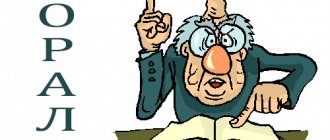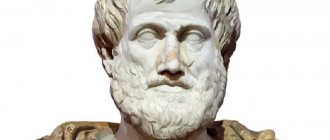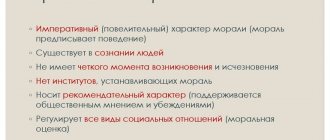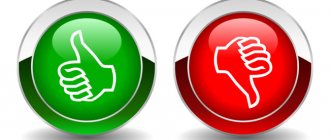Morality is a conditional concept of rules, principles, assessments, norms based on the paradigm of assessments of evil and good, which was formed in a certain period of time. This is a model of social consciousness, a method of regulating the behavior of a subject in society. It develops both in individual and social forms of subjective relations.
The concept of morality from the point of view considered by psychologists is a fragment of the human psyche, formed at a deep level, responsible for assessing events occurring in various planes with the meaning of good and bad. The word morality is often used as a synonym for the word morality.
What is morality
The word "morality" originates from classical Latin. It is derived from “mos”, a Latin word meaning character, custom. Referring to Aristotle, Cicero, guided by this meaning, formed the words: “moralis” and “moralitas” - moral and ethics, which became equivalent to expressions from the Greek language: ethics and ethical.
The term “morality” is mainly used to designate the type of behavior of society as a whole, but there are exceptions, for example, Christian or bourgeois morality. Thus, the term is used only in relation to a limited group of the population. Analyzing the attitude of society in different eras of existence to the same action, it should be noted that morality is a conditional value, variable in connection with the accepted social structure. Each nation has its own morality, based on experience and traditions.
Some scientists have also noted that different moral rules apply to subjects not only of different nationalities, but also to subjects belonging to an “alien” group. The definition of a group of people in the vector “friend”, “stranger” occurs at the psychological level of the individual’s relationship with this group in various senses: cultural, ethnic, and others. By identifying himself with a specific group, the subject accepts those rules and norms (morality) that are accepted in it; consider this way of life more fair than following the morality of the whole society.
A person knows a large number of meanings of this concept, which is interpreted from various points of view in various sciences, but its basis remains constant - this is a person’s definition of his actions, the actions of society in the equivalent of “good or bad.”
Morality is created on the basis of the paradigm adopted in a particular society, since the designations of “good or bad” are relative, not absolute, and the explanation of the morality or immorality of various types of acts is conditional.
Morality, as a combination of rules and norms of society, is formed over a long period on the basis of traditions and laws adopted in a particular society. For comparison, you can use the example associated with the burning of witches - women who were suspected of using magic and witchcraft. In a period such as the Middle Ages, against the background of adopted laws, such an action was considered a highly moral act, that is, good. In the modern paradigm of adopted laws, such atrocity is considered an absolutely unacceptable and stupid crime against the subject. At the same time, you can put such incidents as holy wars, genocide or slavery. In their era, in a particular society with its own laws, such actions were accepted as the norm and were considered absolutely moral.
The formation of morality is directly related to the evolution of various ethnic groups of humanity in its social key. Scientists who study the social evolution of peoples consider morality to be the result of the influence of the forces of evolution on the group as a whole and on individuals individually. Based on their understanding, behavioral norms prescribed by morality change during the evolution of humanity, ensuring the survival of species and their reproduction, and guaranteeing the success of evolution. Along with this, the subject forms in himself a “pro-social” fundamental part of the psyche. As a result, a feeling of responsibility for what was done, a feeling of empathy, and guilt are formed.
Accordingly, morality is a certain set of behavioral norms that is formed over a long period of time, under the influence of environmental conditions at a certain moment it forms a set of established ideological norms that contribute to the development of human cooperation. It is also aimed at avoiding the individualism of the subject in society; formation of groups united by a common worldview. Sociobiologists consider this point of view in a number of species of social animals; there is a desire to change behavior aimed at survival and preservation of one’s own species during the period of evolution. Which corresponds to the formation of morality, even in animals. In humans, moral norms are more sophisticated and diverse, but they are also concentrated on preventing individualism in behavior, which contributes to the formation of nationalities and, accordingly, increases the chances of survival. It is believed that even such norms of behavior as parental love are consequences of the evolution of human morality - this type of behavior increases the level of survival of offspring.
Studies of the human brain conducted by sociobiologists determine that the parts of the subject's cerebral cortex that are involved when a person is preoccupied with moral issues do not form a separate cognitive subsystem. Often, during the period of solving moral problems, areas of the brain are activated that localize the neural network responsible for the subject’s ideas about the intentions of others. To the same extent, the neural network responsible for the individual’s representation of the emotional experience of other individuals is involved. That is, when solving moral problems, a person uses those parts of his brain that correspond to empathy and compassion, this indicates that morality is aimed at developing mutual understanding between subjects (an individual’s ability to see things through the eyes of another subject, to understand his feelings and experiences). According to the theory of moral psychology, morality as such develops and changes as the personality develops. There are several approaches to understanding the formation of morality at the personal level:
– cognitive approach (Jean Piaget, Lorenz Kohlberg and Eliot Turiel) – morality in personal development goes through several constructive stages or areas;
– biological approach (Jonathan Haidt and Martin Hoffman) – morality is considered against the background of the development of the social or emotional component of the human psyche. Interesting for the development of the doctrine of morality as a psychological component of personality is the approach of psychoanalyst Sigmund Freud, who suggested that morality is formed as a consequence of the desire of the “superego” to get out of a state of shame and guilt.
The structure of morality
The phenomena that we classify as moral are extremely heterogeneous. These are the actions and behavior of both individuals and their groups; moral relations between people; a person’s moral attitude towards everything around him; psychological properties of individuals, their “moral character”; moral motives, motives, will; values; rules and requirements for behavior - norms; concepts of honor, dignity, duty, etc. The list goes on. What morality is “made” of! And all these are not just different components, but phenomena of a different order, which is why it is difficult to systematize them. The structure of morality is multi-tiered and multifaceted; it is impossible to cover it at the same time. Let's imagine just some of its options.
I. The very way in which morality is illuminated determines its visible structure. Various approaches reveal its various aspects: biological - studies the prerequisites of morality at the level of an individual organism and at the population level; psychological - examines the psychological mechanisms that ensure the fulfillment of moral norms; sociological - clarifies the social conditions in which morals develop, and the role of morality in maintaining the stability of society;
normative - formulates morality as a system of duties, regulations, ideals;
personal - sees the same ideal ideas in a personal refraction, as a fact of individual consciousness; philosophical - represents morality as a special world, the world of the meaning of life and the purpose of man.
These six aspects can be represented by the colors of the faces of a Rubik's Cube. A cube that is fundamentally impossible to solve, i.e. achieve monochromatic edges, a single-plane vision. Considering morality on the one hand, we have to take others into account. So this structuring is very conditional.
II. A very simple version of the structure of morality was outlined in ancient times. After all, morality is, on the one hand, concepts, beliefs, intentions, and on the other, actions, practical actions. The combination of word and deed is the essence of the moral attitude to reality and moral relations between people. In total, there are three elements: consciousness, activity and relationships connecting them.
III. Finally, the structure of morality is of interest from the point of view of the degree of complexity of the regulatory impact exerted by certain moral ideas. The simplest form of moral statements is a norm: “thou shalt not kill,” “thou shalt not steal,” “do this.” The norm determines behavior in some typical situations that have been repeated for thousands of years. And only violation of the norm attracts attention as a blatant disgrace.
In addition to external observance of rules, morality must penetrate into the soul of a person. The ancient Greek sages identified four basic human virtues: wisdom, courage, moderation and justice. Each of the qualities manifests itself in a variety of ways, in a variety of actions. When assessing a person, we most often list these qualities. But it is clear that each of the people is not the embodiment of all perfections, and one advantage may not atone for a bunch of shortcomings. It is not enough to have individual positive traits; they must complement each other, forming a common line of behavior. Usually a person defines it for himself by formulating some moral principles. When we choose principles, we choose a moral orientation as a whole. This is a fundamental choice on which private rules, norms and qualities depend. Loyalty to the chosen moral system (principle) has long been considered a personal dignity. It meant that in any life situation a person would not stray from the moral path. However, the principle is abstract; Once the intended line of behavior sometimes begins to assert itself as the only correct one. Therefore, you must constantly check your principles for humanity and compare them with ideals. An ideal is the ultimate goal towards which moral development is directed; it is either the image of a morally perfect person or a more abstract designation of everything “morally superior.”
Will we realize the ideal in reality? After all, approaching it, we see that we are still far from perfect. However, one should not despair: the ideal is not a standard with which one must coincide, but a generalized image. The ideal inspires our actions, showing in today, in our today's soul, what they should be. As we improve, we improve our ideals, paving our own path to them. This is how an ideal develops a person. My ideal is my tendency of moral development, the innermost “best part” of my own soul. The loss of an ideal or its change turns out to be the most difficult test, because this means the loss of a moral perspective.
In relation to all these levels of moral consciousness, the supreme regulator is the concept of the highest values of morality as such. These usually include freedom, meaning in life and happiness. Value concepts form the basis of our moral orientation; they fascinate the consciousness and permeate it from top to bottom.
So, the components of morality are connected to each other in whimsical ways. Depending on the moral tasks performed, they develop into ever new structures. Morality appears to our eyes not as a fixed object, but as a functional formation.
What are moral standards
Fulfillment of moral norms is the moral duty of the subject; violation of these measures of behavior represents a feeling of moral guilt.
Moral norms in society are generally accepted measures of subject behavior that arise from formed morality. The totality of these norms forms a certain system of rules, which in all respects differ from the normative systems of society such as customs, rights and ethics.
In the early stages of formation, moral norms were directly associated with religion, which prescribes the meaning of divine revelation to moral norms. Each religion has a set of certain moral norms (commandments) that are mandatory for all believers. Failure to comply with prescribed moral standards in religion is considered a sin. In various world religions, there is a certain pattern in accordance with moral standards: theft, murder, adultery, and lies are undeniable rules of behavior for believers.
Researchers studying the formation of moral norms put forward several directions in understanding the meaning of these norms in society. Some believe that compliance with the rules prescribed in morality is a priority in the guise of other norms. Followers of this trend attribute certain properties to these moral norms: universality, categoricalness, immutability, cruelty. The second direction, which is being studied by scientists, suggests that the attribution of absolutism, generally accepted and binding moral norms acts as a kind of fanaticism.
In terms of the form of manifestation, some moral norms in society are similar to legal norms. So the principle “thou shalt not steal” is common to both systems, but by asking the question why a subject follows this principle, one can determine the direction of his thinking. If a subject follows a principle because he is afraid of legal liability, then his act is legal. If the subject confidently follows this principle, because theft is a bad (evil) act, the vector of direction of his behavior follows the moral system. There are precedents in which compliance with moral standards is contrary to the law. A subject, considering it his duty, for example, to steal medicine in order to save his loved one from death, acts morally correctly, while absolutely breaking the law.
Studying the formation of moral norms, scientists came to a certain classification:
– norms affecting questions about the existence of an individual as a biological being (murder);
– norms on the independence of the subject;
– norms of social conflicts;
– norms of trust (loyalty, truthfulness);
– norms relating to the dignity of the subject (honesty, justice);
– confidentiality standards;
– norms about other moral norms.
Answers to other tests in the discipline “Professional Ethics for Lawyers”:
► According to M. S. Strogovich, the social norms operating in society that regulate the actions, behavior of people, their relationships are ...
► Basic concepts of ethical science, reflecting the most essential elements of morality. - This …
► A set of rules of conduct for judges and other professional participants in criminal, civil and administrative proceedings, ensuring the moral nature of their professional activities and off-duty behavior, as well as a scientific discipline that studies the specifics of the manifestation of moral requirements in this area is ...
► Categories of ethics are...
We face moral and ethical issues in our daily lives.
Perhaps these two determine a person's personality, attitude and behavior. The word Morality comes from the Greek word “Mos” which means custom. On the other hand, if we talk about ethics , it also comes from the Greek word "Ethikos" which means character.
Simply put, morality is the customs established by a group of people, while ethics defines the character of an individual. While morality is concerned with the principles of good and evil, ethics is concerned with the right and wrong behavior of a person in a particular situation. Many people use these two terms interchangeably, but there are small and subtle differences between morality and ethics, which are described in the article below.
comparison table
| Basis for comparison | morals | Ethics |
| I mean | Morals are the beliefs of a person or group about what is right or wrong. | Ethics is a guiding principle that helps a person or group decide what is good or bad. |
| What is this? | General principles established by the group | Reaction to a specific situation |
| Root word | Mos meaning custom | Ethikos, which means character |
| Governed by | Sociocultural norms | Individual or legal and professional standards |
| Having dealt with | Principles of good and evil | Right and wrong behavior |
| Business applicability | No | Yes |
| consistency | Morality may differ from society to society and culture to culture. | Ethics are generally the same. |
| expression | Morals are expressed in the form of general rules and statements. | Ethics is abstract. |
| Freedom to think and choose | No | Yes |
Definition of morality
Morals are the social, cultural and religious beliefs or values of a person or group that tell us what is right or wrong. These are the rules and standards adopted by society or culture that we must follow when deciding what is right. Some moral principles:
- Do not cheat
- Be loyal
- Be patient
- I always tell the truth
- Be generous
Morality refers to beliefs that are not objectively right, but which are considered right for any situation, so it can be said that what is morally right cannot be objectively right.
Definition of ethics
Ethics is a branch of philosophy that deals with the principles of behavior of an individual or group. This works as a guiding principle to decide what is good or bad. These are the standards that govern a person's life. Ethics is also known as moral philosophy. Some ethical principles:
- truthfulness
- Honesty
- loyalty
- respect
- justice
- integrity
Functions of morality
Man is a creature with freedom of choice and he has every right to choose the path of following moral standards or vice versa. This choice of a person who puts good or evil on the scales is called a moral choice. Having such freedom of choice in real life, the subject is faced with a difficult task: to follow personal needs or blindly follow what should be. Having made a choice for himself, the subject bears certain moral consequences, for which the subject himself is responsible, both to society and to himself.
Analyzing the features of morality, we can extract several of its functions:
– Regulation function. Following moral principles leaves a certain mark on the consciousness of the individual. The formation of certain views of behavior (what is allowed to be done and what is not allowed) occurs from an early age. This kind of action helps the subject to adjust his behavior in line with usefulness not only for himself, but also for society. Moral norms are capable of regulating the individual beliefs of the subject to the same extent as the interaction between groups of people, which favors the preservation of culture and stability.
– Evaluation function. Morality evaluates actions and situations occurring in a social society in terms of good and evil. The actions that have taken place are assessed for their usefulness or negativeness for further development; after this, each action is given an assessment from the moral side. Thanks to this function, the subject forms the concept of belonging to society and develops his own position in it.
– Function of education. Under the influence of this function, a person develops an awareness of the importance of not only his own needs, but also the needs of the people who surround him. A feeling of empathy and respect arises, which contributes to the harmonious development of relationships in society, understanding the moral ideals of another individual, contributes to a better understanding of each other.
– Control function. Determines control over the use of moral norms, as well as condemnation of their consequences at the societal and individual levels.
– Integration function. Following moral standards unites humanity into a single group, which supports the survival of man as a species. It also helps maintain the integrity of the spiritual world of the individual. The key functions of morality are: evaluative, educational and regulatory. They reflect the social significance of morality.
Test with answers on the topic: “Morals and ethics”
I option.
1. Ethics is a philosophical science that studies a) morality + b) nature c) being d) law
2. An act as a primary element of morality does NOT include... a) intention b) goal c) consequence of an act d) moral norms+
3. In what aspect is the term “morality” understood? a) morality as a type of legal responsibility b) morality as a source of Russian law c) morality as a special form of social consciousness + d) morality as a way to achieve a goal
4. Lawyers for their actions and decisions in the professional field... a) bear increased responsibility + b) bear the same responsibility as everyone else c) bear reduced responsibility d) do not bear any responsibility
5. Morality as a way of regulating human behavior in society is ... a certain set of rights and obligations of the parties a) a system of principles and norms + b) the consciousness of people c) a special structure of legal relations
6. The Latin word “mores” is translated as... a) politeness b) interaction c) relationships d) morals+
7. The category of ethics, which characterizes a person from the point of view of his fulfillment of moral requirements, compliance of his moral activity with moral duty, considered from the standpoint of the individual’s capabilities, is ... a) honor b) justice + c) responsibility d) dignity
8. Concepts of moral consciousness, in which the requirements placed on people are expressed in the form of an image of a morally perfect person, an idea of a person who has absorbed the highest moral qualities - these are ... a) moral aspirations b) moral laws c) moral ideals + d ) moral dogmas
9. According to M. S. Strogovich, the social norms operating in society that regulate the actions, behavior of people, their relationships are ... a) morality + b) ethics c) religion d) ideology
10. Moral principles apply to a) only lawyers b) only those people who agree with such principles c) only the clergy d) all people+
11. The basic concepts of ethical science, which reflect the most essential elements of morality, are ... a) dictionary of ethics b) thesaurus of ethics c) categories of ethics + d) principles of ethics
12. According to A. S. Koblikov, the main function of morality is considered ... a) regulatory + b) prognostic c) communicative d) orienting
13. The term “moral norms” means a) norms ensured by state coercion b) norms adopted among members of a particular organization c) norms governing property relations, as well as non-property relations associated with property d) social norms governing human behavior in society, his attitude towards other people, towards society and towards himself+
14. In moral relations, a person acts as: a) a way of regulating social relations b) a subject in relation to society, a social group, etc.+ c) a subject of research d) an object of moral duties for others+
15. Categories of ethics are... a) the general and special parts of ethical science b) the concepts of ethical science that do not reflect the most essential elements of morality c) all the concepts and terms of ethical science d) the basic concepts of ethical science that reflect the most essential elements of morality+
16. The category of ethics, which in its content is opposite to good, expresses the idea of what contradicts the requirements of morality and deserves condemnation - this is ... a) evil + b) justice c) good d) misfortune
17. A person’s subjective awareness of his responsibility to society, which acts as a duty and responsibility to himself, is... a) conscience + b) happiness c) dignity d) honor
18. Professional ethics plays an important role, especially for professions whose object is ... a) law b) state c) person + d) culture
19. The category of ethics, which means a person’s special moral attitude towards himself and society’s attitude towards him, based on humanistic ideas, is... a) duty b) dignity+ c) honor d) reputation
20. Self-esteem, which is one of the oldest intimate-personal regulators of people’s behavior, is ... a) good b) good c) conscience + d) justice
Option II.
1. Moral sanctions include: a) moral approval+ b) state coercion c) legal sanctions d) moral encouragement+
2. Social norms that regulate a person’s behavior in society, his attitude towards society and towards himself are... a) moral norms + b) corporate norms c) conflict of laws norms d) legal norms
3. Morality is measured by the level of a) social and individual consciousness + b) technical development c) welfare of the population d) material needs of the population
4. Humanism is a) selfless service to one’s neighbor b) preference of one’s own interests over the interests of others c) conscious desire to promote the common good d) recognition of man as the highest value+
5. If a moral norm specifies what specific actions a person should perform, how he should behave in typical situations, then the moral principle gives a person... a) rights and freedoms b) the opportunity to carry out activities c) a set of techniques and methods for carrying out activities d) general area of activity+
6. According to M. S. Strogovich, views, beliefs, ideas about good and evil, about worthy and unworthy behavior are... a) etiquette b) ethics c) law d) moral consciousness+
7. By “moral ethics” is meant: a) the doctrine of. how a person should act + b) the doctrine of the laws of development of society c) the doctrine of the laws of existence d) the doctrine of morality
8. The Latin word “moralis” is translated as ... a) justice b) value c) morality + d) humanism
9. The doctrine of how a person should act, what principles and norms he must follow is ... a) predictive ethics b) moral ethics + c) empirical ethics d) applied ethics
10. When there is a preference for one’s own interests over the interests of others, this is... a) egoism+ b) idealism c) materialism d) formalism
11. As a science, how long has ethics existed? a) more than 20 centuries+ b) more than 10 centuries c) from the end of the 18th century d) from the 4th century BC
12. What is ethics? a) which studies virtues b) about generally accepted and repeated forms of human behavior c) about morality, ethics + d) about morals, customs
13. Select what ethical standards are paid attention to within Western European culture? a) benefit, benefit, hard work b) justice, goodness, goodness + c) honor, freedom, faith
14. Define what morality is? a) rules generally accepted within a social community (group), patterns of behavior or action in a certain situation b) a form of social consciousness that reflects ideas, ideas, principles and rules of behavior of people in society + c) generally accepted and repeated forms of behavior of people that serve as a means of transferring social and cultural experience from generation to generation d) rules of behavior of people when performing rituals and forms of activity
15. Social norms are: a) rules generally accepted within a social community (group), patterns of behavior or action in a certain situation + b) a form of social consciousness that reflects ideas, ideas, principles and rules of behavior of people in society c) generally accepted and repeating forms of human behavior that serve as a means of transmitting social and cultural experience from generation to generation d) rules of behavior of people when performing rituals and forms of activity
16. Traditions – a) rules of behavior that are established and protected by the state. b) represent rules of behavior that are established by public organizations themselves and are protected through measures of social influence provided for by the charters of these organizations. c) spiritual and moral rules of human society, based on people’s idea of God as the creator of the universe. d) the most generalized and stable rules of behavior of people in a particular society, which have been verified by time and have existed for a long time.+
17. The ethical monument “Domostroy” belongs to this country: a) Ancient Greece b) India c) Russia+
18. The norms of public organizations are: a) the most generalized and stable rules of behavior of people in a particular society, which have been verified by time and have existed for a long time. b) rules of behavior that are established and protected by the state. c) rules of behavior that are established by public organizations themselves and are protected through measures of social influence provided for by the charters of these organizations. + d) generally accepted and repeated forms of human behavior that serve as a means of transmitting social and cultural experience from generation to generation.
19. “Deontology” studies: a) the doctrine of rules of conduct b) the doctrine of social mores and customs c) the doctrine of problems of morality and morality, the section of ethics +
20. Founded ethics: a) Plato (428-328 BC) b) the great ancient Greek philosopher Socrates (469-399 BC) + c) Aristotle (384-322 BC) d) Seneca (4 BC – 65 AD)











